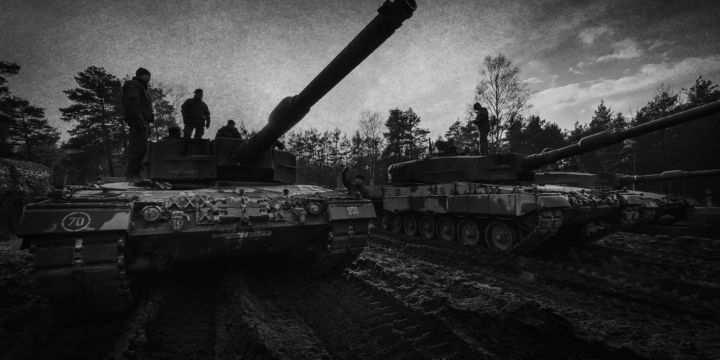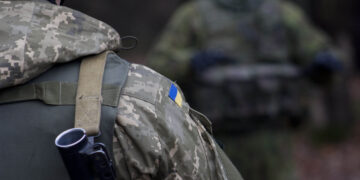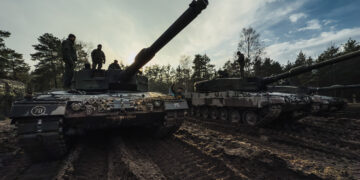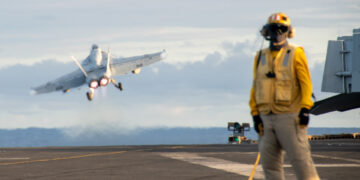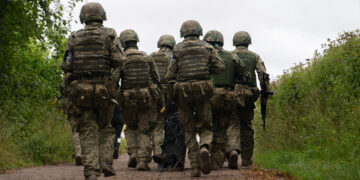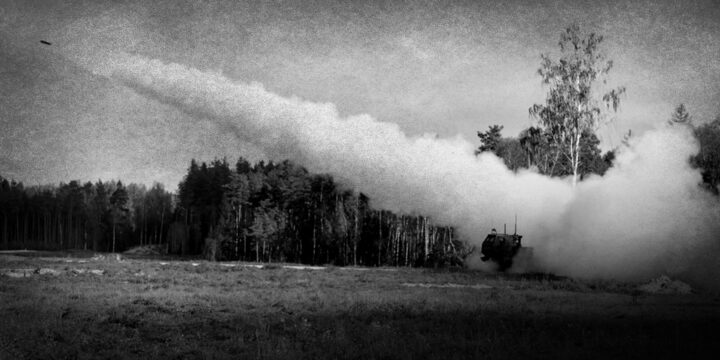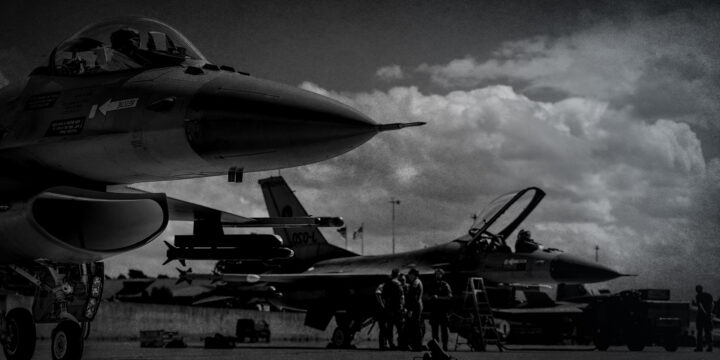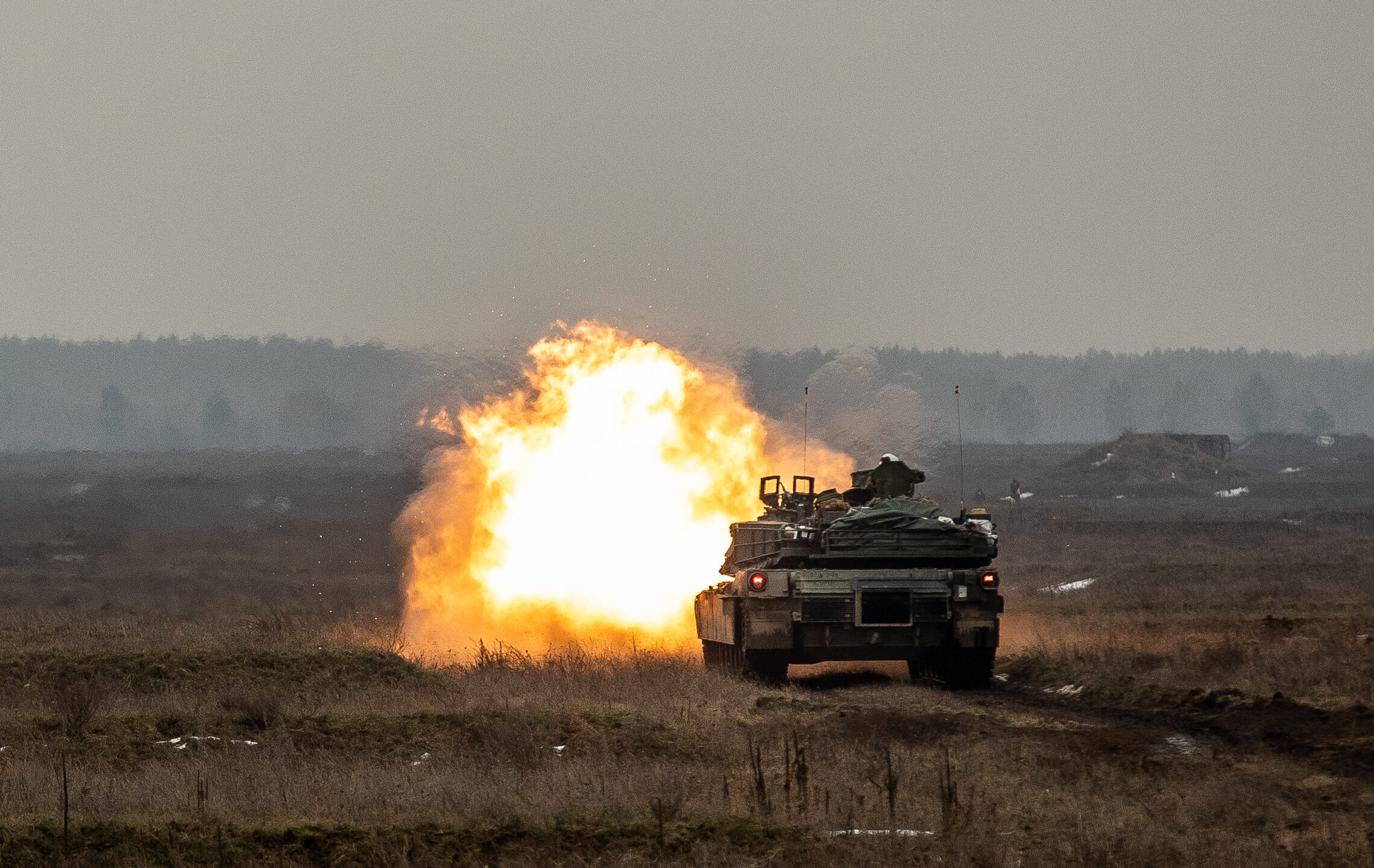
Key priorities for U.S.-Ukraine policy
The United States remains Ukraine’s most prolific backer as it defends itself against Russian aggression. Yet while the Biden administration continues to describe the war in Ukraine as an epic clash between a European democracy and one of the world’s foremost authoritarian powers, it is struggling to overcome growing congressional resistance to further aid. U.S. security interests in the conflict are far narrower than the White House’s rhetoric would suggest.
Indeed, it is not clear the United States has much of a security stake in the outcome at all, however much its sympathies lie with Ukraine. Although one can claim the United States has a long-term interest in preventing Russia from becoming a bigger threat to Europe, it is doubtful that a Ukrainian victory is necessary to achieve it. NATO has successfully deterred Russia from attacking its members and will continue to do so no matter how the war in Ukraine evolves. Even so, United States assistance to Ukraine helps it hold off Russia and reduces the already-low probability of further Russian expansion. Against these limited interests, one should weigh the risk of escalation and the costs of an adversarial U.S.-Russia relationship over the long term.
Given these dangers and the limited benefits of U.S. support for Ukraine, three key objectives should guide U.S.-Ukraine policy:
- avoid escalation to direct U.S. or NATO conflict with a nuclear-armed Russia;
- shift the burden of aiding Ukraine and defending Europe to the Europeans; and
- refuse U.S. security guarantees for Ukraine.1“Perspective on Russia’s Invasion of Ukraine,” Defense Priorities, April 11, 2023, https://www.defensepriorities.org/analysis/ukraine-russia-war.
These aims would shift the war to one funded chiefly by the Europeans, a major step in incentivizing Europe to take primary responsibility for its own defense. And by avoiding security guarantees, the United States would not only lessen its long-term costs, but also improve the chances of ending the war through a settlement.
While an end to the war in Ukraine is not vital to the United States, it is desirable given the dangers—and it is something U.S. policy should at least encourage, whether or not Ukraine regains territory.
Assessing the war after two years of fighting
- As the war in Ukraine enters its third year, the conflict is a slow-grinding war of attrition. Neither the Ukrainian nor Russian army is able to capture strategically significant territory. Russia’s last successful offensive, in Avdiivka, came at a high cost in personnel and materiel, with the Russians possibly sustaining as many as 16,000 fatalities during the four-month operation.2Siobhán O’Grady, et al, “Ukraine suffered losses during chaotic withdrawal as Russia seized Avdiivka,” Washington Post, February 21, 2024, https://www.washingtonpost.com/world/2024/02/21/avdiivka-retreat-casualties-ukraine-russia/. Ukraine has been unable to acquire substantial territory since November 2022, when it pushed Russian forces out of Kherson after a months-long offensive.
- Both combatants remain committed to objectives that are unacceptable to the other side, making a peace treaty or ceasefire unlikely for the time being. Although Russian President Vladimir Putin has claimed an interest in peace talks, his terms—namely Ukraine’s acceptance of Russia’s illegal annexation of Crimea along with Donetsk, Luhansk, Kherson, and Zaporizhia—is strongly rejected by the Ukrainian government and public writ large.3Anton Troianovski, “Putin Calls on U.S. to ‘Negotiate’ on Ukraine in Tucker Carlson Interview,” New York Times, February 8, 2024, https://www.nytimes.com/2024/02/08/world/europe/putin-tucker-carlson-interview.html. Ukraine’s terms, which include Russia’s full withdrawal from Ukrainian territory, including Crimea, reparations for war damage, and war crimes prosecutions for Russian officials, are also unrealistic.4“What is Zelenskyy’s 10-Point Peace Plan?” The Ukrainian Government, November 8, 2023, https://war.ukraine.ua/faq/zelenskyys-10-point-peace-plan/. Russia is as unlikely to capitulate as Ukraine is.
- The war has significantly degraded Russia’s military power. More than 8,800 Russian armored fighting vehicles have been destroyed.5Yohann Michel, “Equipment Losses in Russia’s War on Ukraine Mount,” Military Balance Blog, The International Institute for Strategic Studies, February 12, 2024, https://www.iiss.org/online-analysis/military-balance/2024/02/equipment-losses-in-russias-war-on-ukraine-mount/. The U.S. intelligence community assesses that 315,000 Russian troops have been killed or injured since February 2022. Russia has lost two-thirds of its tank force, one-third of its Black Sea Fleet, and as much as 90 percent of its pre-war army.6Warren P. Strobel and Matthew Luxmoore, “Russia Has Lost Almost 90% of Its Prewar Army, U.S. Intelligence Says,” Wall Street Journal, December 12, 2023, https://www.wsj.com/world/russia/russian-has-lost-almost-90-of-its-prewar-army-u-s-intelligence-says-2e0372ab.
- Ukrainian casualties are likely smaller but still pose severe problems given the Ukrainian army’s smaller manpower pool. Ukraine’s manpower shortages are increasingly apparent, with troops at the front rotated out for only short periods of time due to a lack of reserves. The average age of a Ukrainian soldier is 43.7Simon Shuster, “‘Nobody Believes in Our Victory Like I Do.’ Inside Volodymyr Zelensky’s Struggle to Keep Ukraine in the Fight,” Time, November 1, 2023, https://time.com/6329188/ukraine-volodymyr-zelensky-interview/. General Valery Zaluzhny, Ukraine’s former commander-in-chief of the armed forces, recommended drafting another 450,000 to 500,000 soldiers to hold current positions—a request viewed warily by Ukrainian President Volodymyr Zelensky and one which likely contributed to Zaluzhny’s ouster.8Roman Olearchyk and Ben Hall, “Ukrainian Army Chief Seeks To Mobilize 500,000 More Troops,” Financial Times, December 19, 2023, https://www.ft.com/content/6ba4ae1c-005f-4242-80c2-e1e7f3f7bd88. Ukraine’s counteroffensive last year, which failed to breach Russia’s formidable defensive lines in the east, exacerbated these problems.
- Russia maintains advantages in manpower, ammunition, and armor and boasts an economy nearly 15 times larger than Ukraine’s.9“GDP (current US$) – Russian Federation” and “GDP (current US$) – Ukraine,” The World Bank, 2023, https://data.worldbank.org/indicator/NY.GDP.MKTP.CD?locations=RU, https://data.worldbank.org/indicator/NY.GDP.MKTP.CD?locations=UA. The Russian economy has been mobilized to serve the war effort, whereas Ukraine remains highly dependent on increasingly uncertain Western support for supplies, like artillery shells.
Priority 1: Avoiding escalation to direct U.S.- or NATO-Russia conflict
- The number one U.S. priority with respect to the war in Ukraine is to avoid an escalation that could broaden the war outside of Ukraine’s borders and draw the United States into direct conflict with Russia, a nuclear power.
- Thus far, the Biden administration has navigated military support for Ukraine to prevent hostilities from expanding into NATO territory or going nuclear. A clash between NATO and Russia could pull the United States into the war on behalf of its allies, putting the world’s two largest nuclear powers—the United States and Russia—into direct conflict.
- While the risk of Russian nuclear use in Ukraine remains low, the scenario is not off the table entirely. Russian officials reportedly discussed how to employ tactical nuclear weapons in Ukraine, suggesting the option is still possible, even if low probability.10Helene Cooper, et al, “Russian Military Leaders Discussed Use of Nuclear Weapons, U.S. Officials Say,” New York Times, November 2, 2022, https://www.nytimes.com/2022/11/02/us/politics/russia-ukraine-nuclear-weapons.html. A sudden, desperate collapse of Russia’s conventional forces in Ukraine is a plausible scenario.
- Some foreign policy analysts recommend a concerted, U.S.-supported Ukrainian campaign centered on Crimea, the strategic Black Sea peninsula Russia annexed in 2014, to squeeze the Russian army’s supply lines and increase the cost to Russia of occupying it.11Ben Hodges, et al, “Putin’s Weak Link to Crimea,” Foreign Affairs, December 5, 2023, https://www.foreignaffairs.com/united-states/putins-weak-link-crimea. Others have advocated for an acceleration of Ukrainian strikes inside Russia itself, which proponents claim would increase Putin’s willingness to negotiate on Kyiv’s terms.12Luke Coffey and Peter Rough, “The Shortest Path to Victory in Ukraine Goes Through Crimea,” Foreign Policy, December 8, 2023, https://foreignpolicy.com/2023/12/08/ukraine-russia-war-aid-congress-biden-victory-counteroffensive-crimea/.
- The Biden administration is wise to not follow such recommendations. It would be naïve to assume that the absence of escalation so far means the threat of it is foreclosed entirely. Even a remote risk of nuclear war should prompt the United States to exercise restraint. As a neighboring country and regional power seeking to preserve what’s left of its sphere of influence, Russia’s stakes in Ukraine are greater than those of the United States, and Russia therefore has more credibility when it comes to escalation threats.13Bryan Frederick, et al, Escalation in the War in Ukraine: Lessons Learned and Risks for the Future, Arlington: RAND Corporation, 2023, 76–77, https://www.rand.org/pubs/research_reports/RRA2807-1.html.
- Bilateral U.S.-Russia relations are at their lowest ebb in the post-Cold War era and are highly unlikely to improve in the foreseeable future. Yet both countries have a common interest in guarding against a complete break in ties and preventing a war with each other, which would be catastrophic for all.
- To limit the risks of unintended escalation, the Biden administration should open and maintain diplomatic and military-to-military channels of communication with Russia. These channels could be used for the purposes of sending messages, understanding one another’s positions, and exploring possible agreements in distinct areas (arms control and risk reduction) when circumstances warrant.14Michael K. Bohn, “Hot Line: Even Without a Cold War, the Washington-Moscow Link is Still Up,” Washington Post, August 1, 2013, https://www.washingtonpost.com/lifestyle/magazine/hot-line-even-without-a-cold-war-the-washington-moscow-link-is-still-up/2013/07/31/5f3305d8-ea34-11e2-8f22-de4bd2a2bd39_story.html. Even more important is to avoid getting into a situation where Russia is desperate enough to take terrible risks to win.
Priority 2: Shifting security burdens to Europe
- The United States has been the leading supplier of military assistance to the Ukrainian army since the war began. At $46 billion, the U.S. provides more military aid than the EU, the United Kingdom, Germany, France, Italy, Denmark, the Netherlands, and Poland combined.15Pietro Bomprezzi, et al, “Ukraine Support Tracker,” The Kiel Institute for the World Economy, last updated February 16, 2024, https://www.ifw-kiel.de/topics/war-against-ukraine/ukraine-support-tracker/?cookieLevel=accept-all. This despite the fact that the outcome in Ukraine matters far more to Europe than it does to the United States due to geography. The European Union and its member states have committed $150 billion in military, financial, and humanitarian aid to Ukraine since the war began, but only half of that has been allocated.16Erika Solomon and Constant Méheut, “Zelensky Visits Berlin and Paris to Shore Up Support as U.S. Wavers,” New York Times, February 16, 2024, https://www.nytimes.com/2024/02/16/world/europe/zelensky-europe-berlin-paris.html. The EU will only be able to deliver half of the 1 million rounds of ammunition it promised to Ukraine by this March.17Laura Kayali, et al, “EU To Ukraine: “You’ll Get Half the Ammo We Promised in March,” Politico Europe, January 31, 2024, https://www.politico.eu/article/eu-to-ukraine-half-is-better-than-nothing-when-it-comes-to-ammunition/.
- Despite the largest land war in Europe in nearly 80 years, the continent is still dependent on the United States for defense. As of 2023, 19 of NATO’s 30 members failed to meet the alliance’s defense spending benchmark of 2 percent of GDP.18“Defence Expenditure of NATO Countries (2014–2023),” The North Atlantic Treaty Organization, July 7, 2023, https://www.nato.int/nato_static_fl2014/assets/pdf/2023/7/pdf/230707-def-exp-2023-en.pdf. Germany, the wealthiest country in Europe with a GDP of $4.8 trillion, has slowed the implementation of its special $108 billion fund for the Bundeswehr, which suffers from years of structural deficiencies, poor recruitment, and lackluster equipment.19“Policy statement by Olaf Scholz, Chancellor of the Federal Republic of Germany and Member of the German Bundestag, 27 February 2022 in Berlin,” press release by the German Government, February 27, 2022, https://www.bundesregierung.de/breg-en/news/policy-statement-by-olaf-scholz-chancellor-of-the-federal-republic-of-germany-and-member-of-the-german-bundestag-27-february-2022-in-berlin-2008378.
- If Europeans feel insufficiently threatened by Russia to raise their defense budgets and better integrate their militaries, that is their prerogative. The United States should not feel obligated to fill in the gaps or preface U.S. drawdowns from Europe on greater European self-sufficiency.
- While higher European defense budgets would be a welcome development for the United States, this is far less important than burden shifting—making Europe take primary ownership of its own security.
- Currently, the United States is undermining its own policy objectives in Europe. Like its predecessors, the Biden administration continues to call on European allies to increase their defense budgets and rebuild their militaries after a decades-long peace dividend. Yet after Russia’s invasion of Ukraine, the United States added 20,000 troops to its forces in Europe, bringing the total to more than 100,000 troops.20“FACT SHEET – U.S. Defense Contributions to Europe,” U.S. Department of Defense, June 29, 2022, https://www.defense.gov/News/Releases/Release/Article/3078056/fact-sheet-us-defense-contributions-to-europe/. And U.S. leaders have discouraged European moves toward strategic autonomy—collective military capability outside the U.S.-dominated NATO framework.21Rajan Menon and Daniel R. DePetris, “Europe Doesn’t Need the United States Anymore,” Foreign Policy, January 30, 2023, https://foreignpolicy.com/2023/01/30/nato-europe-eu-defense-united-states/. The result is a continuation of the status quo: a NATO wholly reliant on U.S. military power, which perpetuates the same European dependency the United States complains about.22Mike Sweeney, “How Would Europe Defend Itself?” Defense Priorities, April 11, 2023, https://www.defensepriorities.org/explainers/how-would-europe-defend-itself.
- Instead, the United States should take steps toward actual burden shifting, which would make NATO a more equitable military alliance and reduce the U.S. military presence while working to prevent the emergence of a Eurasian hegemon. Steps Europe could take include: establishing a European defense industrial base that can streamline weapons production; creating an all-European quick reaction force, which could deploy when a security crisis emerges; and staffing troop deployments in Europe’s eastern flank exclusively with European troops.23Rajan Menon, “Reconfiguring NATO: The Case for Burden Shifting,” Defense Priorities, December 23, 2022, https://www.defensepriorities.org/explainers/reconfiguring-nato-the-case-for-burden-shifting.
- Some argue that Russia’s invasion of Ukraine demonstrates why the United States must remain Europe’s main security provider. This view is wrong. The war in Ukraine and Russia’s poor performance to date reveals the exact opposite: the Russian military, bogged down in Ukraine, is conventionally weak, makes poor tactical and strategic decisions, expends immense resources for limited tactical gains, and lacks the capacity to invade NATO territory even if it wanted to. Assuming Europe judges Russia to be a long-term security threat, the optimal time for Europe to take responsibility for its own defense is now while Russian military capabilities are tied up in Ukraine.
- The war in Ukraine is a European problem first, and one they can manage.24Justin Logan, “Uncle Sucker,” Cato Institute, Policy Analysis No. 940, March 7, 2023, https://www.cato.org/policy-analysis/uncle-sucker#recommendations-policymakers. Ultimately, the stakes in Ukraine are higher for Europe than they are for the United States, whose overarching policy of preventing a Eurasian hegemon will remain well-established regardless of Ukraine’s geopolitical trajectory.
- The United Kingdom, Germany, and France have all signed 10-year bilateral security assistance deals with Ukraine, pledging long-term military weapons supplies and training to the Ukrainian army as well as deeper coordination with the Ukrainian defense industry.25“Agreement on security cooperation and long-term support between Ukraine and the Federal Republic of Germany,” Office of the President of Ukraine, February 16, 2024, https://www.president.gov.ua/en/news/ugoda-pro-spivrobitnictvo-u-sferi-bezpeki-ta-dovgostrokovu-p-88985. Such deals are a positive development, enabling the U.S. to hand the Ukraine file to the Europeans.
Priority 3: No U.S. security guarantees for Ukraine, in NATO or otherwise
- Under no circumstances should the United States fight on Ukraine’s behalf, either through a bilateral defense agreement or through NATO.
- Proponents claim nothing short of a NATO or U.S. security guarantee will stop Russian aggression in Ukraine. Russia, however, is highly unlikely to stop fighting, let alone settle the war through negotiation, if it knows Ukraine will be granted NATO membership or treated as a U.S. treaty ally once the conflict ends.26Christopher McCallion, “Assessing Realist and Liberal Expectations for the Russo-Ukrainian War,” Defense Priorities, June 7, 2023, https://www.defensepriorities.org/explainers/assessing-realist-and-liberal-explanations-for-the-russo-ukrainian-war. A U.S. defense commitment to Ukraine is mostly cost and risk for the United States and will likely lengthen the war.
- Even if the U.S. did offer a security guarantee to Ukraine, Russia is unlikely to view it as credible given the manifest unwillingness of the United States and its European allies to fight, die, and risk nuclear war on Ukraine’s behalf.27Benjamin H. Friedman, “Neutrality Not NATO: Assessing Security Options for Ukraine,” Defense Priorities, July 12, 2023, https://www.defensepriorities.org/explainers/neutrality-not-nato. Such a guarantee, whether it’s a unilateral U.S. commitment or Ukraine’s entry into NATO, would mean Ukraine would be under the U.S. nuclear umbrella just like any other NATO or treaty ally. Taken to the extreme, the United States would then be committed to fighting a nuclear war with Russia to defend Ukraine. The United States wisely refuses to do this in the present—it should not do so in the future, and it’s difficult to imagine Russia believing it ever would.
- While doubts remain about its sincerity, the United States officially keeps the door to NATO membership open for Ukraine at some undefined point in the future, a position Secretary of State Antony Blinken reaffirmed in January 2024.28“Secretary Antony J. Blinken and NATO Secretary General Jens Stoltenberg at a Joint Press Availability,” U.S. Department of State, January 29, 2024, https://www.state.gov/secretary-antony-j-blinken-and-nato-secretary-general-jens-stoltenberg-at-a-joint-press-availability-3/. In reality, this is empty rhetoric. The unanimity among members required to bring Ukraine into NATO isn’t there, with Germany consistently opposed to the idea and the United States often deferring the accession process for the sake of preserving NATO unity.
- Rather than providing Ukraine with a false sense of security, the United States should be honest and shut the door to NATO membership permanently. Keeping it open is morally objectionable, doesn’t do Ukraine any favors, discourages Ukraine from making the challenging but necessary compromises required for a potential peace deal, and adds more risk to the alliance—and by extension the United States—as a whole.
Armed neutrality as the way forward
Russia’s ongoing invasion of Ukraine aside, the balance of power in Europe remains favorable to the United States and its European allies. Russia is not primed for hegemony: While the Russian economy has performed better than expected under U.S. and European Union sanctions, it is still roughly the size of Italy’s economy; its military is exhausting resources against a numerically inferior Ukrainian army; and its economic ties with Europe, once its largest consumer, are near-broken.
Ukraine’s importance to U.S. grand strategy is limited.29Joshua Shifrinson, “American Interests in the Ukraine War,” Defense Priorities, September 14, 2022, https://www.defensepriorities.org/explainers/american-interests-in-the-ukraine-war. Even so, the United States has an interest in assisting Ukraine’s legitimate defense needs and ending the war.
The U.S. should adopt a three-pronged approach. First, any future U.S. military support should cajole Ukraine into establishing a defensive strategy, which would play to its strengths in degrading Russia’s capabilities and better preserve Ukraine’s combat power.30Emma Ashford and Kelly A. Grieco, “How Ukraine Can Win Through Defense,” Foreign Affairs, January 10, 2024, https://www.foreignaffairs.com/ukraine/how-ukraine-can-win-through-defense. Second, the United States should actively pursue exploratory peace or armistice talks between Ukraine and Russia, which have been neglected to date in favor of supporting Ukraine’s maximalist, unrealistic objectives. A diplomatic initiative costs the United States nothing, is the most effective way to determine whether mutually acceptable ends are possible, and, if successful, stems additional loss of life, further Russian advances, and a wider escalation. Finally, regardless of whether a settlement is made, NATO’s perennial open door for Ukraine should be closed and replaced with armed neutrality, whereby the United States and its European allies provide Kyiv with defensive security assistance to frustrate Russia’s attempts at conquest without the costs and risks of a formal defense guarantee. Armed neutrality is not only a more credible arrangement than the empty promise of NATO membership, but also, over time, could degrade Russian military capacity to the point where comprehensive end-of-war settlement talks become feasible.
Endnotes
- 1“Perspective on Russia’s Invasion of Ukraine,” Defense Priorities, April 11, 2023, https://www.defensepriorities.org/analysis/ukraine-russia-war.
- 2Siobhán O’Grady, et al, “Ukraine suffered losses during chaotic withdrawal as Russia seized Avdiivka,” Washington Post, February 21, 2024, https://www.washingtonpost.com/world/2024/02/21/avdiivka-retreat-casualties-ukraine-russia/.
- 3Anton Troianovski, “Putin Calls on U.S. to ‘Negotiate’ on Ukraine in Tucker Carlson Interview,” New York Times, February 8, 2024, https://www.nytimes.com/2024/02/08/world/europe/putin-tucker-carlson-interview.html.
- 4“What is Zelenskyy’s 10-Point Peace Plan?” The Ukrainian Government, November 8, 2023, https://war.ukraine.ua/faq/zelenskyys-10-point-peace-plan/.
- 5Yohann Michel, “Equipment Losses in Russia’s War on Ukraine Mount,” Military Balance Blog, The International Institute for Strategic Studies, February 12, 2024, https://www.iiss.org/online-analysis/military-balance/2024/02/equipment-losses-in-russias-war-on-ukraine-mount/.
- 6Warren P. Strobel and Matthew Luxmoore, “Russia Has Lost Almost 90% of Its Prewar Army, U.S. Intelligence Says,” Wall Street Journal, December 12, 2023, https://www.wsj.com/world/russia/russian-has-lost-almost-90-of-its-prewar-army-u-s-intelligence-says-2e0372ab.
- 7Simon Shuster, “‘Nobody Believes in Our Victory Like I Do.’ Inside Volodymyr Zelensky’s Struggle to Keep Ukraine in the Fight,” Time, November 1, 2023, https://time.com/6329188/ukraine-volodymyr-zelensky-interview/.
- 8Roman Olearchyk and Ben Hall, “Ukrainian Army Chief Seeks To Mobilize 500,000 More Troops,” Financial Times, December 19, 2023, https://www.ft.com/content/6ba4ae1c-005f-4242-80c2-e1e7f3f7bd88.
- 9“GDP (current US$) – Russian Federation” and “GDP (current US$) – Ukraine,” The World Bank, 2023, https://data.worldbank.org/indicator/NY.GDP.MKTP.CD?locations=RU, https://data.worldbank.org/indicator/NY.GDP.MKTP.CD?locations=UA.
- 10Helene Cooper, et al, “Russian Military Leaders Discussed Use of Nuclear Weapons, U.S. Officials Say,” New York Times, November 2, 2022, https://www.nytimes.com/2022/11/02/us/politics/russia-ukraine-nuclear-weapons.html.
- 11Ben Hodges, et al, “Putin’s Weak Link to Crimea,” Foreign Affairs, December 5, 2023, https://www.foreignaffairs.com/united-states/putins-weak-link-crimea.
- 12Luke Coffey and Peter Rough, “The Shortest Path to Victory in Ukraine Goes Through Crimea,” Foreign Policy, December 8, 2023, https://foreignpolicy.com/2023/12/08/ukraine-russia-war-aid-congress-biden-victory-counteroffensive-crimea/.
- 13Bryan Frederick, et al, Escalation in the War in Ukraine: Lessons Learned and Risks for the Future, Arlington: RAND Corporation, 2023, 76–77, https://www.rand.org/pubs/research_reports/RRA2807-1.html.
- 14Michael K. Bohn, “Hot Line: Even Without a Cold War, the Washington-Moscow Link is Still Up,” Washington Post, August 1, 2013, https://www.washingtonpost.com/lifestyle/magazine/hot-line-even-without-a-cold-war-the-washington-moscow-link-is-still-up/2013/07/31/5f3305d8-ea34-11e2-8f22-de4bd2a2bd39_story.html.
- 15Pietro Bomprezzi, et al, “Ukraine Support Tracker,” The Kiel Institute for the World Economy, last updated February 16, 2024, https://www.ifw-kiel.de/topics/war-against-ukraine/ukraine-support-tracker/?cookieLevel=accept-all.
- 16Erika Solomon and Constant Méheut, “Zelensky Visits Berlin and Paris to Shore Up Support as U.S. Wavers,” New York Times, February 16, 2024, https://www.nytimes.com/2024/02/16/world/europe/zelensky-europe-berlin-paris.html.
- 17Laura Kayali, et al, “EU To Ukraine: “You’ll Get Half the Ammo We Promised in March,” Politico Europe, January 31, 2024, https://www.politico.eu/article/eu-to-ukraine-half-is-better-than-nothing-when-it-comes-to-ammunition/.
- 18“Defence Expenditure of NATO Countries (2014–2023),” The North Atlantic Treaty Organization, July 7, 2023, https://www.nato.int/nato_static_fl2014/assets/pdf/2023/7/pdf/230707-def-exp-2023-en.pdf.
- 19“Policy statement by Olaf Scholz, Chancellor of the Federal Republic of Germany and Member of the German Bundestag, 27 February 2022 in Berlin,” press release by the German Government, February 27, 2022, https://www.bundesregierung.de/breg-en/news/policy-statement-by-olaf-scholz-chancellor-of-the-federal-republic-of-germany-and-member-of-the-german-bundestag-27-february-2022-in-berlin-2008378.
- 20“FACT SHEET – U.S. Defense Contributions to Europe,” U.S. Department of Defense, June 29, 2022, https://www.defense.gov/News/Releases/Release/Article/3078056/fact-sheet-us-defense-contributions-to-europe/.
- 21Rajan Menon and Daniel R. DePetris, “Europe Doesn’t Need the United States Anymore,” Foreign Policy, January 30, 2023, https://foreignpolicy.com/2023/01/30/nato-europe-eu-defense-united-states/.
- 22Mike Sweeney, “How Would Europe Defend Itself?” Defense Priorities, April 11, 2023, https://www.defensepriorities.org/explainers/how-would-europe-defend-itself.
- 23Rajan Menon, “Reconfiguring NATO: The Case for Burden Shifting,” Defense Priorities, December 23, 2022, https://www.defensepriorities.org/explainers/reconfiguring-nato-the-case-for-burden-shifting.
- 24Justin Logan, “Uncle Sucker,” Cato Institute, Policy Analysis No. 940, March 7, 2023, https://www.cato.org/policy-analysis/uncle-sucker#recommendations-policymakers.
- 25“Agreement on security cooperation and long-term support between Ukraine and the Federal Republic of Germany,” Office of the President of Ukraine, February 16, 2024, https://www.president.gov.ua/en/news/ugoda-pro-spivrobitnictvo-u-sferi-bezpeki-ta-dovgostrokovu-p-88985.
- 26Christopher McCallion, “Assessing Realist and Liberal Expectations for the Russo-Ukrainian War,” Defense Priorities, June 7, 2023, https://www.defensepriorities.org/explainers/assessing-realist-and-liberal-explanations-for-the-russo-ukrainian-war.
- 27Benjamin H. Friedman, “Neutrality Not NATO: Assessing Security Options for Ukraine,” Defense Priorities, July 12, 2023, https://www.defensepriorities.org/explainers/neutrality-not-nato.
- 28“Secretary Antony J. Blinken and NATO Secretary General Jens Stoltenberg at a Joint Press Availability,” U.S. Department of State, January 29, 2024, https://www.state.gov/secretary-antony-j-blinken-and-nato-secretary-general-jens-stoltenberg-at-a-joint-press-availability-3/.
- 29Joshua Shifrinson, “American Interests in the Ukraine War,” Defense Priorities, September 14, 2022, https://www.defensepriorities.org/explainers/american-interests-in-the-ukraine-war.
- 30Emma Ashford and Kelly A. Grieco, “How Ukraine Can Win Through Defense,” Foreign Affairs, January 10, 2024, https://www.foreignaffairs.com/ukraine/how-ukraine-can-win-through-defense.
More on Eurasia
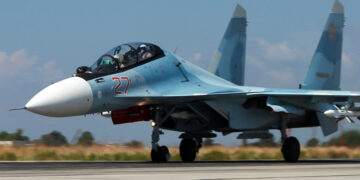
January 13, 2026
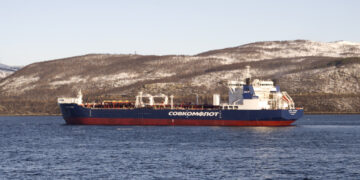
January 8, 2026
Events on Ukraine-Russia
